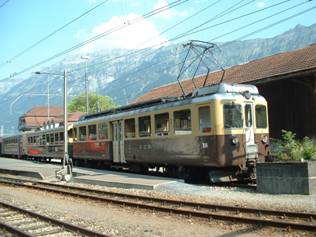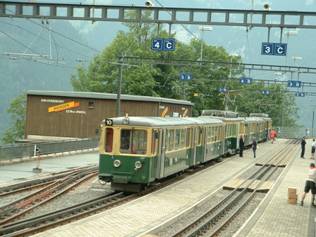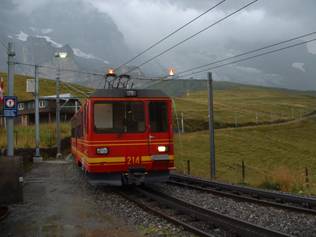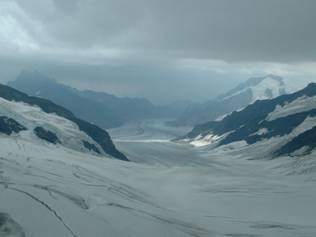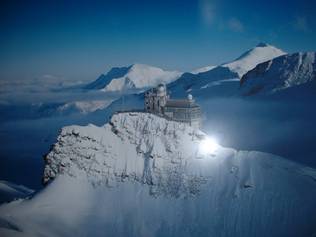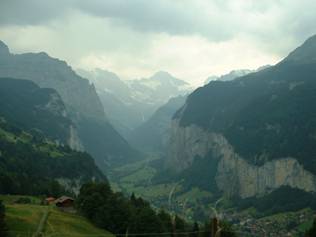|
Journey to the Top of Europe |
||
Our train pulled out of platform 3 at Interlaken Ost station spot on time at 10.20am, the start of our two and a quarter hour journey to the highest railway station in Europe – The Jungfraujoch at 11375 feet above sea level. The trip to the top of the Jungfraujoch had been part of the reason for returning to Switzerland for our summer holiday. We had been to Switzerland many years earlier but in those days simply couldn’t afford to make the trip to the top of the mountain. The Jungfraujoch is the part of the mountain which lies between the Jungfrau and Monch mountains in the Bernese Oberland area of the Swiss Alps. At the foot of these mountains lies the resort of Interlaken which was our base for touring the region. Interlaken is just over two hours by train from either Zurich or Geneva airports which are both easily reached from the UK. We had flown into Zurich from Heathrow a couple of days earlier and caught the train from Zurich airport to Bern then changed to a train for Interlaken that had originally left Amsterdam earlier that morning. Interlaken Ost station has standard gauge tracks at one side for the SBB and BLS mainline services, electrified at 15Kv AC, and metre gauge tracks at the other side for the Brunig line trains, also electrified at 15Kv AC, and Bernese Oberland Bahn trains electrified at 1500v DC. |
|
|
BOB unit at Interlaken Ost |
||
| As we left Interlaken we were at a height
of around 1800 feet and the temperature was 32°C, but
this was soon to change. The 12 coach brown and cream
metre gauge train of the Bernese Oberland Bahn (BOB)
eased out of the station to curve around behind the
outskirts of Interlaken and towards the first stop at
Wilderswil. This railway was first opened on 1st July
1890 and steam operated in its early years, but was
electrified as early as 1914. The small village of Wilderswil itself has nothing particular of note but it is here that you can change trains to catch the 800mm gauge train of the Schynige Platte railway. The Schynige Platte line opened in the summer of 1893 and climbs over 4000 feet to a viewpoint high above Lake Brienz. Continuing on our train starts to climb using rack assistance towards the next stop at Zweilutschinen. Here the train splits into two portions, our front section goes on to Lauterbrunnen whereas the rear portion goes to Grindelwald – which is the way we returned later in the day. These trains split and re-couple every hour in each direction and the process is done so quickly that it is not even noticeable. On leaving Zweilutschinen we pass the BOB depot which houses two preserved steam locomotives that originally worked the line. Our train continues, occasionally using rack assistance, to the terminus at Lauterbrunnen, arriving just 20 minutes after leaving Interlaken, and here we have to change to a WAB (Wengernalp Bahn) train for the next leg of our journey. Lauterbrunnen is only a small village but is dominated by the Staubbeck waterfall that drops over 1000ft over the valley edge high above the village. This is the highest waterfall in Switzerland but one of over 70 waterfalls along this valley. An alternative trip from Lauterbrunnen would be to take the funicular railway from opposite the station (currently being replaced by a cable car) and gradually make your way via the 4¼km metre gauge railway to Murren and then to the Shilthorn mountain by cable car. The revolving restaurant here, at nearly 10000 ft, was built for the James Bond film ‘On Her Majesty’s Secret Service’. |
||
|
The WAB line from Lauterbrunnen via Wengen and Kliene Scheidegg to Grindelwald is the world’s longest continuous rack railway. Our three car WAB train climbs quickly from Lauterbrunnen station, the maximum gradient on this side of the 800mm gauge line is 1 in 5¼, and two more three car units follow close behind us on the single track line. After about ten minutes we come to a passing loop and all three trains wait for three descending trains to pass before we continue up towards Wengen. As we gradually get higher the temperature starts to fall and everyone on the train starts to dip into their rucksacks for a pullover. The scenery is stunning, mountains tower above in all directions with their peaks permanently covered in snow and ice. Several glaciers can also be seen flowing down between the mountains. Wengen lies at a height of 4180 feet and itself is a very popular holiday resort. Its other claim to fame is that it is at the bottom of a ski run that is part of the world cup skiing circuit. After Wengen the climb continues with more amazing views of the mountains and for the first time a clear view of our destination, the Sphinx Observation Building on the Jungfraujoch. |
|
WAB units at Wengen |
||
Our next stop is Kliene Scheidegg where we again change trains. This Jungfrau Bahn train will take us on the final leg of our journey and take a further hour to complete our trip. Kliene Scheidegg is always a busy place with trains arriving from Lauterbrunnen and Grindelwald as well as The Jungfraujoch. After a bit of a scramble to get seats on the Jungfrau train we finally set off on the final 7km of our journey. It is noticeable that most people now have coats or fleeces on as the temperature keeps falling. |
||
| All but the first few hundred
yards of this line are in tunnel. The railway was opened
in 1912, built to metre gauge, and was electrified from
the start, the present system being 1125v DC. The newer
trains of the Jungfrau Bahn are equipped with flat screen
TVs at each end of each coach and give you all the facts
and figures about the railway and the observation
platform as you make your ascent. There are two intermediate stops on the way up. The first is Eigerwand which is a huge cavern behind the north face of the Eiger Mountain. The train stops here for five minutes to let every one get out and look through the windows onto the mountain side. At this point we are just below the snow line and at the snout of one of the glaciers. The next stop is Eismeer, again a huge cavern in the mountain side with a window to look out. This time we are much higher and the mountains here are covered in snow. After this second five minute stop we set off for the top and the train TV screens are telling us what to expect when we get there. The new observation building on the Sphinx Rock was totally rebuilt and reopened in 1996. There is a lift to the observation platform which stands 11782 feet above sea level and the views of the surrounding mountains are amazing. It is also possible to walk out onto the glacier itself and even take a dog sled ride. There is also an ‘Ice Palace’ with some incredible ice sculptures, but its difficult to walk around as the floor is also ice – plenty of handrails to grab hold of though. Thankfully there is also a reasonable café/restaurant here as we were ready for a bite to eat after going outside in the snow. The temperature up here was down to 1.8°C, a fall of over 30° since leaving Interlaken. |
|
|
A Jungfrau train arriving at Kliene Scheidegg |
||
|
|
|
| The Aletsch glacier from the observation platform | The Sphinx observation platform | At Wengen looking down to Lauterbrunnen |
| After spending a couple of hours on the
Jungfraujoch we made our way back to station inside the
mountain to make the non-stop journey back to Kliene
Scheidegg. As we emerged from the tunnel section of the railway the heavens opened and at Kliene Scheidegg we took refuge in the gift shops, missing the first train and waiting another half an hour for our train to Grindelwald. This time our WAB train was only two coaches as this side of the Wengernalp has a maximum gradient of 1 in 4 they prefer to use shorter trains. As on the journey from Lauterbrunnen the trains on this side also run in groups. We were in the second of four two car trains all running a matter of 50 yards apart. The rain had stopped by now and the sun was out again. The more rugged scenery now behind us we were now back in the lush green alpine meadows as we arrived at a passing point. All four trains came into the same passing loop as four more trains passed us making their way back up to Kliene Scheidegg. Continuing on we eventually arrive at Grun, only a few minutes away from Grindelwald, but here we have to reverse. The organisation here has to be seen to be believed as four descending trains arrive as well as a further four ascending trains, both sets of trains arriving from single track routes and having to be swapped to the other single track route. With the usual Swiss precision everything works like clockwork and each train is on its way again in a few minutes. |
||
| At Grindelwald we make our final cross
platform change back to the other line of the BOB. Our
six coach train pulls away from Grindelwald station at 17.35
and heads back towards Interlaken. At Zweilutschinen we
arrive seconds before the portion from Lauterbrunnen, we
couple up and are away again after only a couple of
minutes. We pull into Interlaken station on time at 18.10
and its back to a thin tee shirt as the temperature is
now back to around 30°C. This was the most spectacular train journey I have ever made. The trains may not be anything special in terms of looks or power, but they certainly do a good job in getting several hundred people every day to the top of the mountain and back again. On the other hand the scenery is incredible. Interlaken lies between Lake Brienz and Lake Thun, both lakes have regular ferry services to all the towns and villages along the lake shores. There is also plenty of other railway interest in the region. The town itself has a couple of funicular railways up to the top of nearby hills, there is a model railway near Interlaken West station and the hourly service over the Brunig pass to Lucern is well known as one of Switzerland’s most scenic journeys. The town of Spiez, just along Lake Thun, is a busy junction station on the main line from Germany, through Switzerland, to Italy via the Lotschberg and Simplon tunnels. This line sees a huge volume of freight traffic with trains often double or even triple headed, as well as frequent Eurocity express passenger trains. If you fancy a summer holiday with great scenery and plenty of railway interest, then this is the place to go. |
||
| This article was originally written for the Hull Miniature Railway Society's newsletter 'Topline' | ||
| Martin | ||
